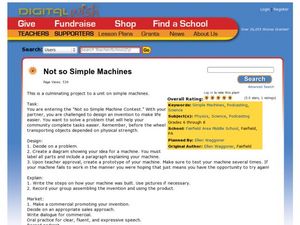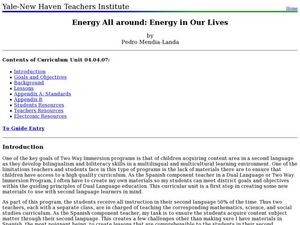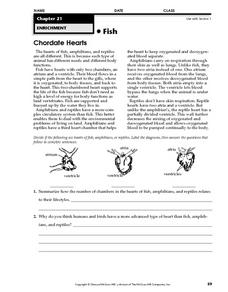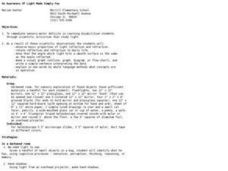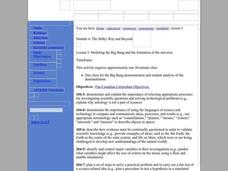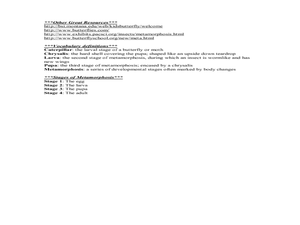Curated OER
Not So Simple Machines
Students design a simple machine for a simple machine contest. In this simple machine lesson plan, students design a simple machine that will solve a problem. They draw a diagram, label it, and test the machine before they present it in...
Curated OER
Simple Machines
In this simple machine worksheet, students review the definitions of different simple machines including levers, wheels, and inclined planes. Students match the 7 words to their definitions and then place the words in to a word puzzle.
Curated OER
Energy All Around: Energy in Our Lives
Young scholars identify the different sources of energy. In this energy lesson, students list different machines and identify the type of energy used to operate them. They create a diagram of a wind turbine and label its parts.
Curated OER
Seismometer
All this resource provides is a black line diagram of a simple seismometer and two sentences explaining how it works. Use this as a transparency or display it through your projector when studying tectonic activity. It would be especially...
Curated OER
Parts of a Tree
Second graders examine the parts of a tree and their uses. In this tree lesson, 2nd graders view diagrams of tree parts. Students label a blank tree and discuss the use for each part of the tree.
Curated OER
The Difference Between Comets, Meteors And Asteroids
Students use Venn diagrams to highlight the similarities and differences between comets, meteors, and asteroids.
Curated OER
Chordate Hearts
In this chordate hearts worksheet, students read a passage describing the differences of the hearts of fish, amphibians, and reptiles. After reading, students label diagrams and answer questions.
Curated OER
The Language of Anatomy
Pupils review the concept of anatomical directions. In pairs, they label each other according to those directions and label a diagram of themselves with the directions as well. They participate in a game of "Simon Says" to review the...
Texas State Energy Conservation Office
Investigation: Concept Mapping Fuels
After reading an article, "Fuels for Everything," collaborative groups create a concept map poster of the transportation and non-transportation fuels. This makes a strong introduction to the different types of fuels used for transportion...
Curated OER
Science: Teddy Bear Nation
Students sort teddy bears according to types and then graph the results. They each bring a bear to class and then discuss their similarities and differences. Once the bears have been sorted into groups according to size and color,...
Curated OER
An Awareness of Light Made Simply Fun
Learners with sensory perception issues discover the properties of light through a series of excellent hands on activities. They look at beams of lights in a darkened room; use a kaleidoscope and optical illusions as they experience the...
Curated OER
The Big Bang Theory
Learners will use scientific reasoning to formulate ideas about the formation of the universe using the Big Bang Theory. The use of critical thinking skills is part of the activity and the foundation of the scientific method will serve...
Curated OER
Observing and Sketching the Lunar Surface
Students explore space science by conducting an illustration activity. In this lunar lesson plan, students discuss what the moon is and the role it plays for our environment on Earth. Students view images of the moon and utilize chalk to...
Curated OER
Modeling the Big Bang and the Formation of the Universe
Sixth graders conduct an experiment to understand the Big Bang Theory. In this Big Bang Theory instructional activity, 6th graders will observe a balloon with confetti popping to emulate and analyze information related tot he Big...
Curated OER
Life Cycle of the Monarch Butterfly
Third graders access prior knowledge of the monarch butterfly and discuss what they would like to know. In this Monarch Butterfly lesson,students read Monarch Butterfly and discuss the life cycle of the butterfly. Students gather...
Curated OER
Nucleic Acids and Protein Synthesis
Students cut out the nucleotide models and have an opportunity to relax and chat. Using imagination, students pretend to be molecules acting out protein synthesis and whole body movement.
Curated OER
The amazing and Beautiful Aurora
Learners research the aurora. In this aurora lesson, students participate in a webquest about the aurora. Webquest worksheet is included.
